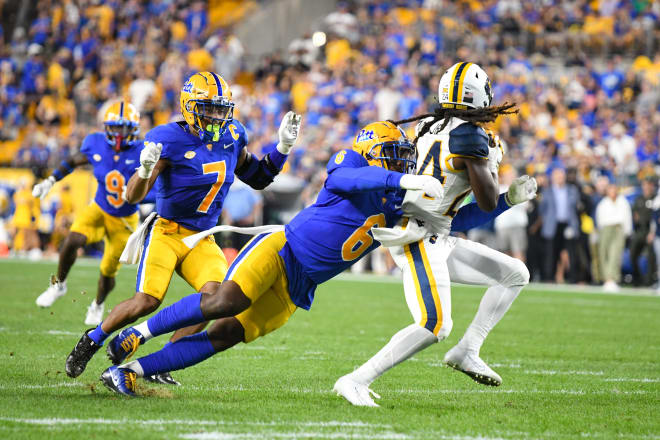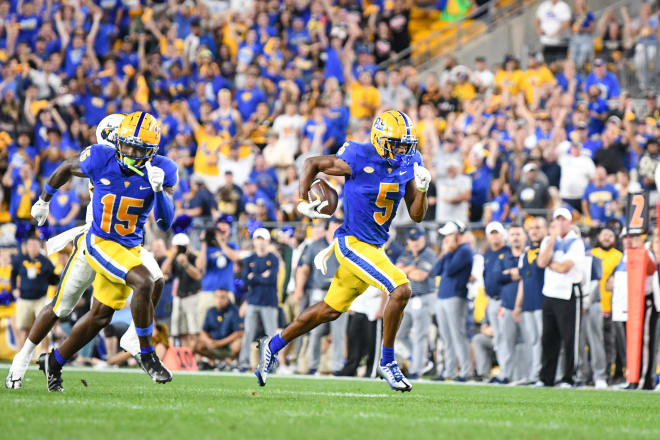The 3-2-1 Column: Moving from the Brawl to another huge game
MORE HEADLINES - Narduzzi talks tempo, Tennessee and more | Video: Narduzzi's final chat before Tennessee | Recruiting rundown: Who's coming to town for Saturday's game? | The Morning Pitt: The opportunity for Pitt, recruiting news, a look around the Coastal and more | Cincinnati DB Beasley's first visit to Pitt Is a memorable one | PODCAST: Tennessee on the horizon | Borbely: "We have to do a better job"
In this week’s 3-2-1 Column, we’re thinking about what’s at stake for Pitt in tomorrow’s game against Tennessee, areas for improvement and a lot more.

THREE THINGS WE KNOW
You’re both right
Sometimes, two things can be true, even if they seem to stand in opposition to each other, or at least be a little contradictory.
A discussion on the message board this week considered the question of just how big Saturday’s game against Tennessee at Acrisure Stadium is for Pitt. The premise of the thread was that the game is huge, and any attempt to deny or downplay the significance of the game on the basis of it not impacting the ACC race was misguided, since this team’s aspirations go above and beyond the conference, and in that sense, this game looms large.
And that’s absolutely correct.
The counterpoint is that the 2022 Pitt football team has a lot it can accomplish even if it doesn’t find itself inside the top four or top eight in mid-November. A second consecutive Coastal title and ACC Championship Game appearance, potential back-to-back league titles and 20+ wins over two seasons would all count as major accomplishments for a program looking to take a step to the next level of the sport.
And that’s absolutely correct, too.
This is the reality for Pitt right now. The Tennessee game is huge, but it’s not everything. There are goals for this season that can hinge quite a bit on the outcome Saturday, but those are not the only goals this team has, and a loss doesn’t eliminate all of the goals.
Win or lose on Saturday, the Coastal Division and the ACC as a whole are still on the table. Win or lose, a 10-win season is still on the table. Really, win or lose, the national conversation is still on the table.
Look at Utah. The Utes were a preseason darling, seen as possibly the Pac-12’s best hope of breaking the conference’s College Football Playoff drought. But after opening the season with a No. 7 ranking, Utah lost at unranked Florida last weekend, and yet there is still plenty of talk nationally about how the Utes can climb back into the conversation.
One loss, particularly to a Power Five opponent, is not a killer. It greatly decreases the margin for error, but one loss does not close all doors permanently, especially if it happens early in the season. Just like Utah has plenty of time to make its case as one of the top four teams in the country, so too will Pitt have that kind of opportunity if Saturday doesn’t go the home team’s way.
The path is much more clear if the Panthers beat Tennessee; no question about that. But the path still exists, even in the event of a loss.
Ultimately, there’s a lot riding on this game for Pitt. National perception, a definite bump in the rankings and a clear shot at being in the important conversations come mid-October and early November - not to mention huge implications in recruiting - are all on the line. The Panthers can make a major statement about who they are. They can tell the world of college football that it needs to pay attention.
But if it doesn’t work out, there are 10 more games left to make those very same statements, and I think this team is good enough to do just that.
So whether you say this is a big game or you say there’s a lot of season left…
You’re right.

The run defense will be fine
If there’s one thing Pitt should be reliable for, it’s run defense.
When Pat Narduzzi arrived in December 2014, he immediately started talking about how important it is to stop the run, and he hasn’t stopped talking about it since.
It’s not just talk, too; Pitt’s defense has been designed to stop the run since Narduzzi came to town (and even longer before that) and it has been more or less effective. 2018 was the low-water mark of the Narduzzi era - 178.3 rushing yards per game allowed, No. 80 nationally and No. 9 in the conference - the last three years since then have been impressive.
In 2019, 2020 and 2021, Pitt ranked no worse than 12 in the nation in run defense while leading the ACC in that category. The Panthers were No. 12 nationally in 2019, giving up a little more than 100 yards per game on the ground, and then climbed to No. 3 in 2020 and No. 6 last season while holding opponents to 93.5 and 89.3 yards per game, respectively.
In fact, since giving up 264 rushing yards to Boston College in the 2019 regular-season finale, no Pitt opponent had topped two bills in 26 consecutive games.
West Virginia damn near broke that streak last Thursday night. The Mountaineers finished the Backyard Brawl with 190 net rushing yards, a total that suffered from JT Daniels losing 22 yards on three sacks; minus those three plays, WVU topped 200.
How did it happen?
There’s a variety of reasons, and we’ll talk about some of them in a moment, but I’ll say this outright:
I’m not worried about the run defense.
There are plenty of things to worry about heading into Saturday’s game against Tennessee. The pass defense, for instance, is going to be tested and will probably give up more than a couple big plays. The offense also has a lot to prove after an inconsistent performance - on a number of levels - against WVU.
I have my questions and maybe even doubts about those areas of the team. But the run defense? Not so much.
I know that, in most situations, it’s not sound reasoning to blindly give coaches the benefit of the doubt. But in this particular instance, I do think that Narduzzi and company have earned it. They’ve just been that good at stopping the run over the years - especially the last three - that it’s not a large leap to assume they will figure it out.
Obviously, that needs to happen sooner rather than later. Pitt didn’t give up too much to Tennessee’s ground game last season - 103 of the Volunteers’ 136 net rushing yards were gained by quarterbacks Joe Milton and Hendon Hooker - but Tennessee ran wild against Ball State in the 2022 season opener, finishing with 218 rushing yards and five touchdowns on the ground.
Pitt is not Ball State, so the sledding should be a bit tougher for the Volunteers. But we all know how dangerous the Tennessee passing attack is; if the Volunteers get going in the run game, it’s going to be really, really tough for the Panthers to get to 2-0.
I’m counting on the run defense looking more Pitt-like - more Narduzzi-like - tomorrow.

Growing pains
A seamless transition, it was not.
I think we all knew that the 11-win ACC champion wasn’t going to just slide into 2022 and pick up right where it left off, not with Kenny Pickett gone to the Pittsburgh Steelers and Jordan Addison gone to USC and Mark Whipple gone to Nebraska. I think we all knew there would be a period of adjustment, a span of time where the absence of those key figures was felt as their replacements worked to get up to speed.
That’s natural. Transition is part of college sports, where eligibility restraints inevitably result in some amount of roster turnover every offseason.
In most years, you have a warmup game to ease into that transition. That’s what Pitt had in 2021 (UMass), 2020 (Austin Peay) and 2018 (Albany); even if the Panthers weren’t breaking in a new quarterback those seasons, they still had those lighter openers to get the season started.
And the last time Pitt was breaking in a new quarterback, the Panthers opened 2017 with Youngstown State (never mind that that particular “warmup” game nearly turned into a disastrous loss in overtime).
Of course, there was no such warmup game to ease the transition this year. Pitt’s new starters at quarterback, receiver and outside linebacker were thrown to the lions with not just any Power Five opponent but a Power Five opponent who happens to be one of the program’s most hated rivals returning to the schedule after an 11-year absence.
Oh, and it took place in front of the largest crowd to ever attend a sporting event in the city of Pittsburgh.
So yeah, no easing in there, and the growing pains showed. Pitt returned a lot of starters this season, but there were a few holes to fill in the lineup, and those players were inevitably going to take some time to work up to the level they need to be at.
It’s not a surprise that Kedon Slovis took a little time to adjust to the new offense and line and skill players. It’s not a surprise that the receivers weren’t totally sharp. It’s not a surprise that the outside linebackers didn’t have all their fits and alignments exactly perfect. It’s not a surprise that the new Aussie rules punter misjudged the timing on one of his punts.
None of that should have been a surprise, and if it was, then that’s on us for expecting something more seamless - and probably unrealistic.
That it happened in a game against a Power Five opponent led to a one-score result and a down-to-the-wire contest. Working out those kinks against Rhode Island might have been a bit smoother.
Now, as Pat Narduzzi said on Thursday, those players are battle-tested, and while they certainly won’t be perfect against Tennessee on Saturday, they’ve got a whole lot of experience to build from. Week by week, the growing pains should lessen as the team gels. They just need it to happen a little quicker.

TWO QUESTIONS WE HAVE
Can Pitt win a shootout?
This isn’t a new one.
I know we’ve asked this in a 3-2-1 Column before (at least once and maybe more). I know I’ve talked about it on the Panther-Lair Show. I brought it up on Wednesday’s Morning Pitt. And I have thought about it more times than I would care to admit.
It’s just that big of a question.
Can this Pitt team, in its current incarnation from the coaching booth to the field, win a shootout?
Look, we’ve all watched this defense for seven seasons. We know what it is susceptible to. We’ve seen it happen in every one of those seven seasons.
We’ve seen teams attack Pitt through the air and, quite often, find a whole lot of success doing so.
Last season, though, we saw something we haven’t really seen from Narduzzi’s teams outside of possibly the 2016 group:
We saw a team that could go blow-for-blow with a potent offense.
Put another way - and tying this back together - we saw a team that could compete in a shootout.
Now, they didn’t always win the shootouts. I would call the Western Michigan game a shootout - 44-41 seems to qualify - and I would say the same about the Miami game; both were shootouts and Pitt came out on the losing end.
But those games weren’t losses due to a lack of offense. Pitt scored 75 points and piled up more than 1,000 yards of offense in those two losses; some unimaginable defensive play against WMU and a couple crucial offensive errors against Miami led to those defeats. But the offense did a whole lot of heavy lifting in those games, and I would stand by my statement that the 2021 Panthers were more than capable of winning shootouts.
Is this team built that way, though?
That’s been the big question in the aftermath of the departure trifecta: without Mark Whipple, without Kenny Pickett, without Jordan Addison, can Pitt win that kind of game?
That question remains to be answered.
We all know what we saw last Thursday night. For the most part, it didn’t look like a team that could do it. That was certainly the case in the first half. But Pitt did score three offensive touchdowns after halftime, which is a pretty solid 42-point pace. Can the Panthers carry over that success and do it for 60 minutes?
They’re going to have to, certainly at various points over the course of the season and probably this weekend. Tennessee’s offense has shown no signs of slowing down, either in tempo or in production, after the Volunteers finished the 2021 as the No. 7 scoring offense in the nation.
Pitt was No. 3 in that category, and while the Panthers might not need to be all of that to win a lot this season, they’ll probably need to be somewhere close to that stratosphere on Saturday.
And then we’ll find out the answer to that question.

Were the lessons learned?
Coaches always like to say that the biggest improvement of a season comes between Week 1 and Week 2. The idea there being that the players learn and internalize the biggest lessons after live game action, after facing another team for the first time and finding out just exactly what they didn’t know, understand or fully appreciate during all of those training camp practices.
Guess what?
It’s not just the players who should have learned lessons from Pitt’s win over West Virginia.
At least, it better not just be the players who learned lessons, because there were plenty of lessons for the Pitt coaching staff to learn, too.
I think both coordinators - Frank Cignetti for the offense, Randy Bates for the defense - came out of the Backyard Brawl with a much better understanding of the players they have and what those players can do. Or, at the very least, what those players are capable of doing right now, two weeks into the season.
Let’s start with Cignetti, whose offense put up 384 yards and 31 points against WVU. He came out of that game with plenty to learn, particularly regarding the right kinds of formations and play calls for Kedon Slovis, and there’s some optimism from me in that regard.
In the first half, Pitt had 154 yards and 10 points and Slovis had thrown for 84 yards. In the second half, the Panthers put up 230 yards and 21 offensive points as Slovis went 10-of-16 for 224 yards and a touchdown.
To me, that says improvement. That says Cignetti adjusted and found more success calling plays that worked for Slovis and the offense. I’m bullish on the idea of those lessons carrying over.
The defense is a little more interesting, if only because there wasn’t a similar second-half improvement. WVU scored 10 points in the first half on 187 total yards and, most notably, 81 rushing yards. In the second half, the Mountaineers scored 21 points and gained 217 yards, with 109 of those yards coming on the ground.
You know Pat Narduzzi was displeased by that. He said so himself - multiple times. He also said on Monday that perhaps the Pitt coaches had too much in the playbook on defense, that perhaps the staff over-prepared to account for the uncertainty of what WVU, with a new offensive coordinator of its own, might try to do, and that led to the players having too much on their collective plate.
Maybe that’s the explanation. And if it is, that should be good thing, because the awareness of over-preparation combined with a more solid knowledge of what Tennessee will likely do - on account of facing the Volunteers last season and two other Josh Heupel-led teams in 2018 and 2019 - should allow the coaches to hone in on specifics with the players this week.
That would seem to make sense. We’ll see if it works out.
Mostly, we’ll see what the coaches learned from the win over West Virginia. There were plenty of lessons; can they take those lessons and turn them into improvement on Saturday?

ONE PREDICTION
Slovis will have a “prettier” game
It was interesting to watch how the narrative shifted over the last week on Kedon Slovis and his play against West Virginia.
In the immediate aftermath of the game, the reviews weren’t very positive. Slovis held onto the ball too long, didn’t show much in the way of mobility, missed one or two big-play opportunities and generally put the drop-off from Kenny Pickett on full display.
But as the dust settled, things shifted. Pat Narduzzi said as much at his weekly press conference on Monday.
“I thought Kedon played a really good game, really good, better than I thought when I watched it live.”
The “better than I thought” theme was prevalent. I even experienced it right after the game when I first glanced at the box score and found, to my surprise, that Slovis had thrown for 300 yards. Watching the game, I would have guessed he barely topped 200, and while he benefited from yards after the catch - as all quarterbacks do - getting over 300 is impressive and speaks to the kind of game he played.
Narduzzi also said several times this week that some of the sacks Slovis took - five in all - were less on the quarterback sitting in the pocket too long and more on the receivers not being sharp enough in their routes and details.
I think that stuff is correctable. It should be, at least, and while it seems to harken back to Narduzzi’s comments two weeks ago that the receivers were giving him “chest pains,” perhaps the experience of actually being in a game and seeing what kind of attention to detail is demanded can, um, “inspire” those receivers to step up a bit.
I’m counting on some improvement in that regard, and if it happens, that should translate to improvement for Slovis. A 16-of-24/308-yard performance with no turnovers might not show a lot of room for improvement on paper, but if the receivers get it together and the offensive line makes some progress of its own, I think that Slovis can have a game on Saturday that looks a lot better.
I think that will happen. I think Slovis will pass the eye test much better than he did a week ago. I think he’ll get rid of the ball a little quicker. I think he’ll show a little better pocket presence. And I think he’ll hit a couple deep throws, giving him more air yardage than he had against WVU.
It may or may not translate to a win - at the risk of repeating myself, I still need to be convinced that this offense can compete in a shootout, and there are other factors (like the defense) that are going to impact this one - but I think it’s entirely possible and actually likely that we come out of this game feeling better overall about Slovis and his prospects for leading this team, regardless of the game’s outcome.
